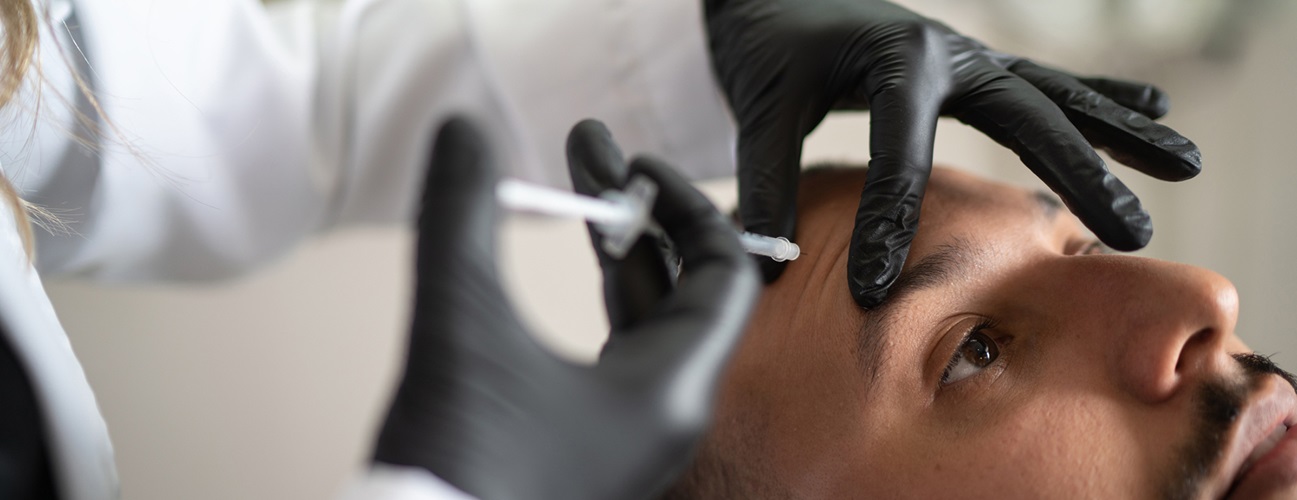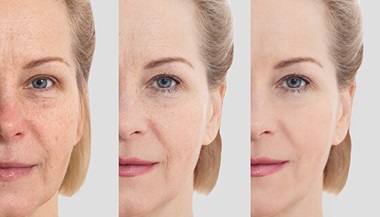Botulinum Toxin Injectables for Migraines
Featured Expert:
Wrinkle-reducing treatments that use botulinum toxin injectables may also be used to treat chronic migraines. These treatments, known as neuromodulating drugs (such as Botox, Dysport, Xeomin and Mybloc), were approved by the U.S. Food and Drug Administration in 2010 for migraine treatment.
Plastic and reconstructive surgeon Sashank Reddy, M.D., Ph.D., explains how these drugs are a powerful treatment option for patients with chronic migraines.
What You Need to Know
- The injectables used to treat migraines are the same kind used by aesthetic surgeons and dermatologists to minimize facial wrinkles.
- Licensed medical professionals treat migraines by injecting botulinum toxin into multiple areas around the head and neck.
- The treatments are approved for select people age 18 and older who experience 15 or more migraine days per month.
- It may take four weeks or more after treatment before you see a reduction in the frequency of your migraines, and more than one set of injections may be needed.
How do botulinum toxin injectables help treat migraines?
Researchers are eager to learn how botulinum toxin-based drugs help relieve migraine pain. Evidence suggests that the drug interrupts the pathway of pain transmission between the brain (central nervous system) and nerves that extend from the spinal cord.
When you have a migraine, your body releases substances called neurotransmitters and molecules that are associated with pain. Botulinum toxin interferes with the transmission of these substances, typically where the nerves and muscles meet. Researchers think that when the drug is injected into the muscles around the face, head and neck, it is taken up by the nerves and interferes with pain-associated neurotransmission.
Why might I need botulinum toxin injections for migraine treatment?
Botulinum toxin treatments have been proved effective in clinical trials, and are one way to treat chronic migraines. Other medications, and lifestyle changes, might be recommended. If your doctor determines that you have chronic migraines, you might be a candidate for this treatment.
Sashank Reddy says, “Botulinum toxin injectables are part of a comprehensive suite of options that neurologists and headache specialists have for treatment of chronic migraines. While no single option is best for all cases, an approach that includes several different treatments can often reduce headache frequency and severity.”
Migraine Treatment with Injectables — What to Expect
Using a very small needle, a specialist injects botulinum toxin into the tiny muscles under your skin throughout various areas around your face, head and neck.
You might get injections in your forehead, temples, and the back of your head and neck. Sometimes the specialist will inject areas called “trigger points” where the headache pain originates.
“These treatments for chronic migraines should be individualized, respecting the unique anatomy and origin points of pain in each patient,” Reddy says.
It can take several weeks and multiple treatments before you start experiencing relief from your migraines. Some patients find they can discontinue injections without frequent migraines returning. Others need regular treatments to keep migraines under control.
“Injectables can be effective in reducing the frequency of headaches in patients with chronic migraine and can also reduce debilitating symptoms associated with these migraines,” says Reddy.
What are the risks of using injectables for migraines?
Botulinum toxin injectables should be avoided by pregnant women and nursing mothers, as well as people with an allergy to proteins in cow’s milk.
When given by an experienced and qualified health care specialist, botulinum toxin injections are relatively safe. However, some people experience pain, bruising or swelling where the drug was injected. Other possible side effects are:
- Headache or flulike symptoms
- Dry or watering eye
- Drooping on one eyelid, eyebrow or side of the mouth
- Drooling
Very rarely, if the toxin accidentally spreads into your body, other, more serious symptoms might occur over the course of hours or days. Call your doctor right away if you notice:
- Vision problems
- Muscle weakness
- Trouble speaking or swallowing
- Inability to control the bladder
- Difficulty breathing






